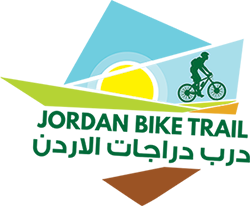
Getting to Jordan
Visa:
Most visitors can buy one month visitor visas for 40JOD at most points of entry. Check the Jordan Tourism Board website for specific visa requirements for your country of origin. If you intend to visit Petra, buy a Jordan Pass in advance of your arrival. While there are various prices/options, the basic 70JOD pass covers your Jordan visitor visa fee and a one day visit to Petra (normally 50JOD), in addition to free entrance to most of Jordan’s other tourist sites.
Arriving by Air:
You can pay for your Jordan visa upon arrival at Amman’s Queen Alia Airport. From the airport, buses travel to Amman every hour, on the hour from between 6am and midnight. Overnight, buses leave at 1am, 3am, and 5am. These buses cannot accommodate large bike boxes, but if you have your bike packed in a smaller box and/or both wheels are removed, it’s possible to fit the bike in the bus’s luggage compartment. Tickets cost 3.30JOD.
Taxis from the airport to Amman cost 20-25JOD. Some with roof racks can strap larger bike boxes to the top.
Land Crossings:
There are three land crossing between Jordan and Israel/Palestine. You can find more information on the Jordan Tourism Board website.
Sheikh Hussein Border/North Crossing: People of most nationalities can buy their visitor visa upon arrival. On the Jordanian side of the border, there’s a taxi stand with listed prices to various Jordanian cities. You can take a taxi directly to Um Qais from here.
Allenby Bridge/King Hussein Bridge: Be aware that you must have a Jordanian visa in advance if you are crossing into Jordan at this point of entry. Taxis from the Jordanian side of the border to Amman cost 30JOD.
Wadi Araba/South Crossing: If you cross at this border, the Jordanian entry visa fee is waived as long as you return through this same border crossing. If you exit by another border, you’ll be charged the visitor visa fee when you leave. You must take a taxi from the Jordanian side of the crossing to Aqaba (12-15JOD; expensive, but it’s the price). From Aqaba, JETT buses travel to Amman multiple times daily (8-10JOD).
Amman to Um Qais:
Getting to the start of the trail in Um Qais can be a hassle. A taxi/truck from Amman will cost at least 60JOD.
Alternatively, you can try to get to Um Qais by public transportation. This will take all day. (See more on public transportation in Jordan.) You can also take a JETT bus to Irbid from Amman, then taxi from there to Um Qais.
When to Go
Spring (Mar-Apr) and Fall (Oct-Dec) are the best seasons to ride the Jordan Bike Trail. During these times of year, temperatures will be comfortable. In the spring, you’re more likely to see flowers in bloom in the North, but there’s a higher likelihood of some rain. In the fall, you’re unlikely to see rain, but there will be less visible plant life. In the extremely arid South, you’re less likely to see rain at all, regardless of the time of year.
Winter is a suitable time to ride the route. Much of the route (particularly the southern half after Kerak) near or above 1000m. Winter temperatures can actually be quite cool (lows often below freezing), and you may encounter snow (although this isn’t likely). In the North, you’re much more likely to encounter rain/mud in the winter months (Jan-Feb).
Summer is not an ideal time to ride. Average temperatures in Amman (800m) are above 32C/90F in Jul/Aug (although temperatures are often much higher), and much of the route is exposed without shade. Moreover, many of the route’s major climbs start from low elevations (ranging from -200m to 200m) in canyon valleys. There, summer temperatures regularly exceed 38C/100F.
Try to avoid riding during Ramadan (see Jordanian Culture), as many stores and restaurants will be closed. (And, it’s impolite to eat/drink in front of people who are fasting.)
